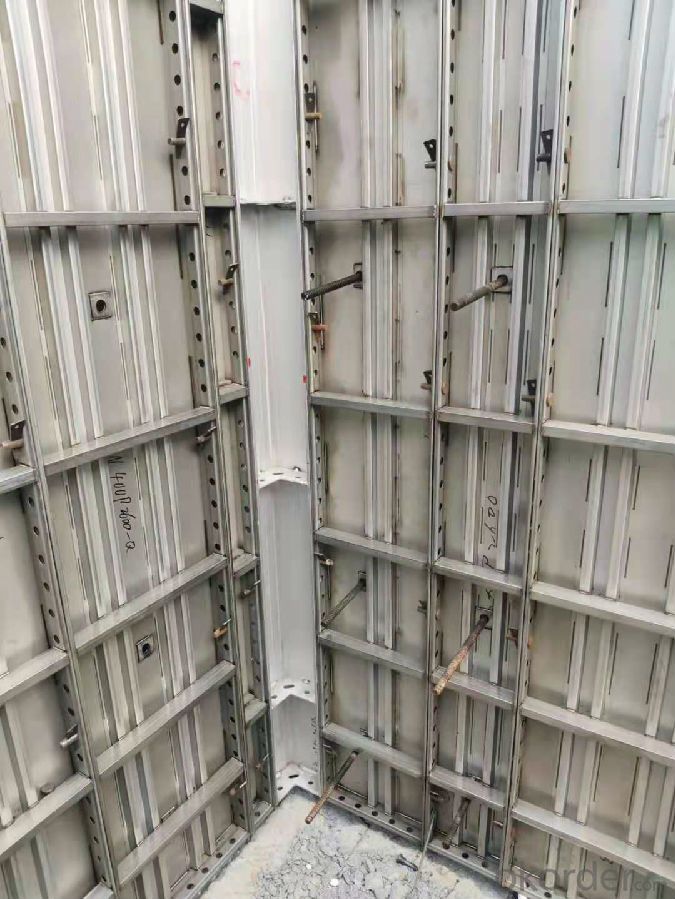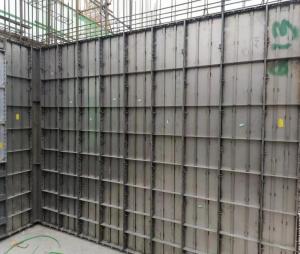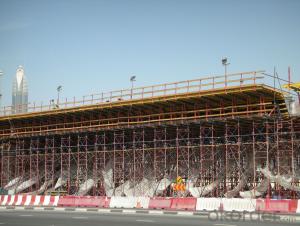Best qaulity of precast formwork,construction concrete column formwork, Stainless Steel Formwork
- Loading Port:
- Shanghai
- Payment Terms:
- TT or LC
- Min Order Qty:
- 1 set
- Supply Capability:
- 1000000 set/month
OKorder Service Pledge
OKorder Financial Service
You Might Also Like
Stainless steel formwork
Replaceable size aluminum formwork :400X1200mm , 400X1500mm
FORMWORK FOR building PROJECTS
modular panel formwork, for on-site concrete jobs where a fair-faced finish is required or where extremely high concrete pressures occur
The panels are made of a high-quality stainless steel frame and a top quality 5mm stainless steel sheeting. The sheet lies on top of the profiles so the joints between the panels are reduced to a very thin line.
Advantages:
1 Stainless steel formwork, 100% follow the design of aluminum alloy formwork system, it is interchangeable, compatible and can be used together with aluminum formwork at the same time .
2It is made of high-strength stainless steel strip by rolling and laser welding. It has good corrosion resistance and high density,is not easy to rust and has no fire hazard.
3Long service life, many turnover times, high recycling value
The number of turnovers is large, especially the characteristics of no dust, no need to brush or less mold release agent, and the characteristics of low renovation costs will bring unlimited optimistic prospects to it.



- Q: What are the weight limits for steel formwork panels?
- Several factors, including panel thickness, dimensions, steel type, and project requirements, can cause weight limits for steel formwork panels to vary. Steel formwork panels are typically built to endure heavy loads and offer structural support while concrete is being poured and cured. Nevertheless, it is crucial to consult the manufacturer or supplier for precise weight limits and load-bearing capacities. They can provide comprehensive technical specifications and guidelines to ensure the secure and effective utilization of the panels at construction sites.
- Q: How does steel formwork handle concrete pouring and consolidation?
- Steel formwork is a popular choice for concrete pouring and consolidation due to its strength, durability, and ease of use. When it comes to handling concrete pouring and consolidation, steel formwork offers several advantages. Firstly, steel formwork provides a solid and rigid structure that can withstand the pressure exerted by the weight of the concrete. This ensures that the formwork remains stable throughout the pouring and consolidation process, preventing any deformations or collapses that could compromise the quality of the concrete structure. Additionally, steel formwork is highly resistant to moisture and chemicals present in the concrete mix, which helps to maintain its integrity and durability. This resistance ensures that the formwork does not get damaged or corroded during the pouring and consolidation process, thereby prolonging its lifespan and reducing maintenance costs. Moreover, steel formwork allows for efficient and precise concrete placement and consolidation. The smooth surfaces of steel formwork facilitate the easy flow and distribution of the concrete, ensuring that it fills all the required areas evenly. This helps to eliminate voids and air pockets, resulting in a denser and more structurally sound concrete structure. Furthermore, steel formwork can be easily adjusted and customized to meet specific project requirements. Its modular nature allows for easy assembly and disassembly, making it a cost-effective choice for various construction projects. The flexibility of steel formwork also allows for the creation of complex shapes and designs, enabling architects and engineers to realize their creative visions. In conclusion, steel formwork is an ideal choice for handling concrete pouring and consolidation due to its strength, durability, and versatility. It provides a stable and robust structure that can withstand the weight and pressure of the concrete, while also ensuring efficient and precise placement and consolidation. These qualities make steel formwork a reliable and practical solution for a wide range of construction projects.
- Q: Can steel formwork be used for energy-efficient concrete buildings?
- Energy-efficient concrete buildings can utilize steel formwork. The strength, durability, and versatility of steel formwork make it a suitable option for constructing energy-efficient structures. Precise design and construction are achievable with steel formwork, which is essential for achieving energy efficiency in buildings. Architects and engineers can customize steel formwork to create intricate designs and complex shapes, allowing for the incorporation of energy-efficient features like insulated walls, solar shading devices, and efficient HVAC systems. Furthermore, steel formwork offers excellent thermal conductivity, which helps maintain consistent indoor temperatures and reduces energy consumption. By using steel formwork, concrete walls and floors can be designed with insulation materials that provide high thermal resistance, minimizing heat transfer through the building envelope. This reduces the energy required for heating and cooling, resulting in improved energy efficiency. In addition, steel formwork is easily reusable, reducing construction waste and promoting sustainability. It can be dismantled and reassembled for multiple projects, making it a cost-effective and environmentally friendly choice. Choosing steel formwork for energy-efficient concrete buildings not only minimizes energy consumption but also reduces the overall environmental impact. To conclude, steel formwork is an effective choice for constructing energy-efficient concrete buildings. Its strength, durability, versatility, and thermal conductivity make it suitable for incorporating energy-efficient features into the building design. Moreover, its reusability promotes sustainability, making steel formwork a viable option for creating energy-efficient structures.
- Q: What are the different types of form ties used in steel formwork systems?
- In steel formwork systems, there exist various form ties that serve to establish a secure bond between the formwork panels and supporting structures. 1. Conventional Form Ties: The most commonly employed form ties are those comprised of a steel rod with cones or washers on both ends. These rods are inserted through the formwork panels and secured using nuts or wedges, resulting in a robust connection. 2. Coil Ties: These ties are constructed from a continuous loop of wire, often galvanized to resist corrosion. They are simple to install and remove, and can accommodate different concrete wall thicknesses by adjusting the loop length. 3. She-Bolts: Alternatively referred to as she-bolts or coil bolts, these form ties consist of a threaded rod embedded in the concrete wall, along with a plate and nut on the external side. They establish a sturdy connection and find common usage in scenarios where frequent formwork removal and repositioning is necessary. 4. Snap Ties: Equipped with a flat plate on one end and a snap-tie wedge on the other, these ties are easily and swiftly installed without any special tools. They offer a dependable connection and are suitable for light to medium-duty applications. 5. Plastic Cone Ties: Designed for use with reusable plastic formwork systems, these ties are made from plastic material. They possess a lightweight nature, are easy to handle, and exhibit excellent resistance to chemical corrosion. 6. Flat Ties: Strip or bar-shaped, flat ties are utilized to connect formwork panels. Typically crafted from steel, they can be readily bent or cut to the desired length. These ties are frequently employed in scenarios where the wall thickness is minimal. 7. Wedge Bolts: Comprising a threaded rod, a wedge-shaped plate, and a nut, these form ties are inserted into a hole in the formwork panel. Tightening the nut secures the connection. Wedge bolts are commonly employed in situations requiring high strength and rapid installation. These aforementioned examples merely represent a selection of the various form ties adopted within steel formwork systems. The choice of form tie is contingent upon factors such as the application, concrete wall thickness, desired strength, and ease of installation and removal.
- Q: What are the weight limitations of steel formwork?
- The weight limitations of steel formwork depend on various factors such as the type and thickness of the steel used, the design of the formwork system, and the support structure. Generally, steel formwork is known for its high load-bearing capacity and can withstand significant weight. For example, typical steel formwork systems can support concrete loads ranging from 50 to 100 kN/m² (10 to 20 pounds per square foot). However, it is important to consult the manufacturer's specifications and guidelines for the specific formwork system being used as they may have their own weight limitations. Additionally, the weight limitations can also be influenced by the height and width of the formwork panels, the spacing and strength of the supporting beams or columns, and the reinforcement provided for added stability. In summary, steel formwork is known for its strength and ability to withstand considerable weight, but the weight limitations can vary depending on the specific formwork system and its design, as well as the support structure. It is crucial to follow the manufacturer's guidelines and consult with structural engineers to ensure safe and efficient use of steel formwork.
- Q: How does steel formwork compare to aluminum formwork in terms of performance?
- Steel formwork and aluminum formwork are two commonly used materials in the construction industry for creating temporary molds or structures that hold concrete in place until it hardens. While both materials have their advantages and disadvantages, it is important to consider their performance aspects when comparing them. In terms of performance, steel formwork is known for its strength and durability. It has a high load-bearing capacity, making it suitable for heavy-duty applications. Steel formwork can withstand extreme weather conditions, rough handling, and repetitive use without significant wear and tear. The rigidity of steel formwork ensures that the structure maintains its shape during the concrete pouring process, resulting in accurate and precise finishes. Additionally, steel formwork allows for easy customization and modification to meet specific project requirements. On the other hand, aluminum formwork is preferred for its lightweight nature, which makes it easy to handle, transport, and assemble. The lightweight nature of aluminum formwork reduces labor costs and speeds up construction time. It also boasts excellent corrosion resistance, making it suitable for projects near coastal areas or in humid environments. Furthermore, aluminum formwork provides a smooth surface finish on the concrete, requiring minimal or no surface treatment. While both steel and aluminum formwork have their own advantages, the choice between the two depends on the specific requirements of the project. If the project involves heavy loads or requires a high number of reuses, steel formwork should be considered due to its superior strength and durability. However, if the project demands quick assembly, easy handling, and a smooth surface finish, aluminum formwork would be a better choice. Ultimately, the selection of steel or aluminum formwork should be based on a careful evaluation of the project's needs, budget, and timeline. A thorough assessment of the performance aspects, as well as other factors such as cost, maintenance, and environmental impact, will help determine the most suitable formwork material for a particular construction project.
- Q: What are the different sizes and dimensions available for steel formwork panels?
- Steel formwork panels are available in various sizes and dimensions to suit different construction needs. The most common sizes for steel formwork panels are 1.2 meters by 2.4 meters and 1.5 meters by 3 meters. These sizes are widely used in the construction industry due to their versatility and efficiency. The thickness of steel formwork panels can vary depending on the required load-bearing capacity and durability. Typically, steel formwork panels range from 12mm to 18mm in thickness. Thicker panels are often preferred for heavy-duty applications, while thinner panels are suitable for lighter loads. In addition to the standard sizes, custom sizes and dimensions can also be manufactured to meet specific project requirements. This flexibility allows contractors to tailor the formwork panels to their unique construction needs, ensuring optimal performance and efficiency on the job site. It is important to note that the sizes and dimensions of steel formwork panels may vary between manufacturers. Therefore, it is essential to consult with the supplier or manufacturer to determine the available sizes and dimensions for a specific product line. This will ensure that the chosen steel formwork panels are suitable for the intended application and meet the necessary structural requirements.
- Q: How does steel formwork affect the overall waste management of the construction process?
- Steel formwork can have a positive impact on the overall waste management of the construction process. Unlike traditional timber formwork, steel formwork can be reused multiple times, reducing the amount of waste generated during construction. This not only minimizes the need for raw materials but also decreases the amount of waste that needs to be disposed of. Additionally, steel formwork is more durable and resistant to damage, further extending its lifespan and reducing waste. Overall, the use of steel formwork in construction can contribute to a more sustainable and efficient waste management system.
- Q: How does steel formwork compare to timber formwork?
- Construction projects often prefer steel formwork over timber formwork for several reasons. Firstly, steel formwork is highly durable and long-lasting compared to timber formwork. Steel is a resilient material that can withstand heavy loads and harsh weather, making it ideal for multiple uses and reducing the need for frequent replacements. In terms of strength, steel formwork provides greater structural integrity and stability. It can handle higher concrete pressures, allowing for the construction of taller and more complex structures. This is particularly advantageous for high-rise buildings or projects that require large spans. Steel formwork also offers superior dimensional accuracy and consistency. Unlike timber, it does not warp or distort over time, ensuring that the final concrete structure maintains its intended shape and dimensions. This saves time and effort during construction, as fewer adjustments or corrections are necessary. Moreover, steel formwork is easier to clean and maintain. It does not absorb moisture or attract pests like timber does, reducing the risk of deterioration or contamination. Additionally, steel formwork can be easily reused multiple times, making it a more sustainable and cost-effective option in the long run. However, it is important to note that steel formwork generally requires more specialized equipment and skilled labor for assembly and disassembly compared to timber formwork. This may result in higher initial costs and longer setup times for projects. Furthermore, steel formwork may not be suitable for certain applications where weight is a concern, as it is generally heavier than timber. Overall, while both steel and timber formwork have their pros and cons, steel formwork is often preferred in construction due to its durability, strength, dimensional accuracy, and ease of maintenance.
- Q: Is steel formwork suitable for projects with limited skilled labor?
- Steel formwork is an ideal option for projects that lack skilled labor. It is a prefabricated system that can be effortlessly put together and taken apart, making it user-friendly even for unskilled workers. Working with steel formwork does not demand extensive training or specialized skills. Furthermore, steel formwork is incredibly durable and can be reused multiple times, which not only saves costs but also reduces the need for skilled labor throughout the project. The strength and stability of steel formwork guarantee precise and accurate construction, even when skilled labor is limited. Consequently, steel formwork is a suitable and reliable choice for projects with limited skilled labor, as it allows for efficient construction without compromising the project's quality.
Send your message to us
Best qaulity of precast formwork,construction concrete column formwork, Stainless Steel Formwork
- Loading Port:
- Shanghai
- Payment Terms:
- TT or LC
- Min Order Qty:
- 1 set
- Supply Capability:
- 1000000 set/month
OKorder Service Pledge
OKorder Financial Service
Similar products
Hot products
Hot Searches



























